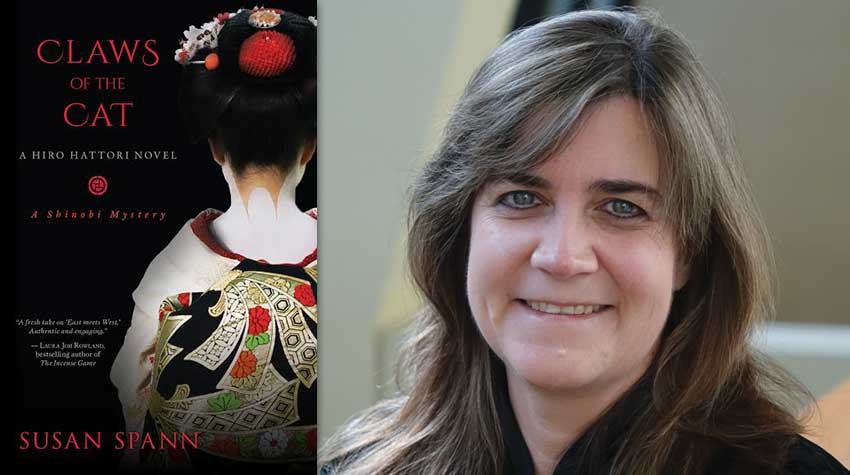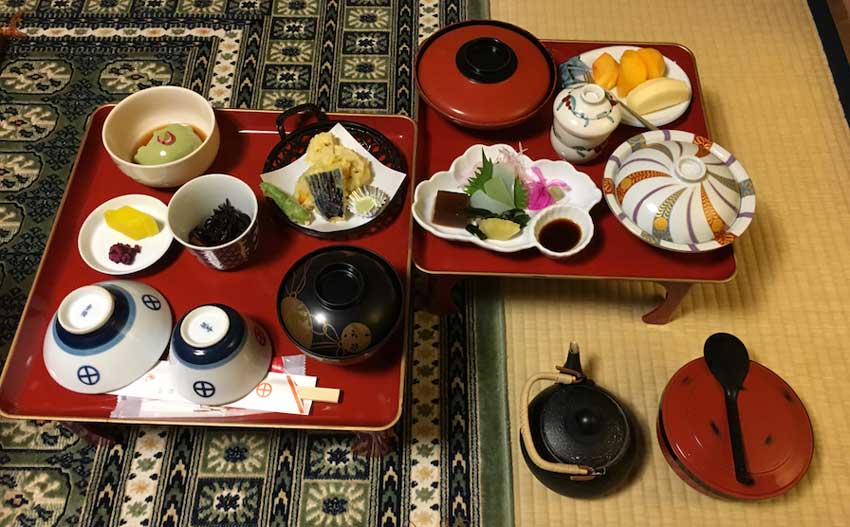Visiting the Scene of the Crime
By Susan Spann
April 24, 2019
An old writing adage says, “Write what you know.” I live (and write) by a personal corollary: “Write where you’ve been.”
I can’t actually visit 16th-century Japan (and given the lack of indoor plumbing, I’m not entirely sure I’d want to), but fortunately, I have been able to visit a number of historical sites and other Japanese locations that helped inspire and enhance the settings of my Hiro Hattori mystery novels.
Although I have a master outline for my series, which gives me a general idea about where my characters need to go, I’m always looking for new and interesting locations in which to set the books. In 2016, I spent the night in a thousand-year-old monastery high on sacred Koyasan, a mountain plateau in Wakayama Prefecture that has been the beating heart of esoteric Buddhism in Japan for over a thousand years. The temple’s wooden halls, tatami-floored guest rooms, and sacred art inspired me, as did the breathtaking views of the forested peaks surrounding the sacred valley. After witnessing a Goma (sacred fire ceremony), where Shingon Buddhist priests chant sutras while a sacred flame consumes the prayers worshippers have written on slender sticks of wood, and eating shojin ryori, a traditional Buddhist temple cuisine, I knew I wanted to introduce readers to this special place.

I was already familiar with esoteric Buddhism, but I didn’t know much about Koyasan, so I spent a year researching the mountain and its history, including two more lengthy trips to Koyasan. Each time, I stayed in one of the dozens of shukubo (temples that offer overnight lodgings to visitors) on the sacred mountain, eating shojin ryori, taking thousands of photographs, and talking with the priests to learn as much as I could about sacred Koyasan. That research and those travels became the basis for Trial on Mount Koya—a mystery that pays homage to Koyasan (as well as to Agatha Christie’s classic And Then There Were None).
Shojin ryori isn’t the only traditional Japanese food that has inspired my writing, either. When traveling in Japan, I try to eat as many local specialties as possible. Almost every Japanese region, prefecture, city, town, and village has a special food, either something they produce or something they prepare in a special way. Many of these dishes have been served for centuries (in one form or another), and since I find food history fascinating—as well as delicious—I’m always on the lookout for something interesting to try. Among my favorites: chewy grilled dango (balls of glutinous rice pounded into mochi) basted with a sweet soy-walnut glaze (a specialty of Magome, in Gifu Prefecture) and the savory red miso soup that’s served in Nagoya.
When I can, I try to include these local specialties in my novels. Even when I can’t feature a specific regional dish, I try to keep my fictitious “recipes” authentic. I want my characters to eat the foods that people ate in their time and place. Tasting as many dishes as I can helps me describe them, too, so whether it’s okonomiyaki (a savory mix of vegetables, meat, and pancake-like batter) grilled at the table in Osaka or deer stew over rice in the mountains of northern Japan, I’m always up for a culinary adventure in Japan.

Travel also helps me identify which facets of medieval Japanese culture I want to feature in upcoming books. Japan has many fascinating local museums and well-preserved historical sites, many of which focus on narrow subjects. For example, Nihon Minka-En, the Japanese Open-Air Folk House Museum in Kawasaki City, south of Tokyo, contains over 20 different historical Japanese houses, preserved and restored to their original condition. Most of the houses date to the 18th and 19th centuries, but some are older—and all are open for visitors to go inside and look around. While most of the houses on display are “newer” than the ones in my novels, many of the architectural elements were carried down from older styles, and it’s helpful to see how the architectural elements I’ve studied and read about look in “real life.”
The Iga Ninja House and Museum in Iga-Ueno (formerly Iga Province, now Mie Prefecture) is another fantastic museum that has proved extremely useful to my work. The ninja weapons on display have featured in many of my novels and will continue to provide inspiration for many books to come. In addition to the “expected” displays of shuriken (“ninja stars”) and ninja clothing, I was able to see and learn about the way real ninjas used smoke bombs, makibishi (caltrops), and even colored rice as tools of espionage. Ninjas used a variety of different tools and weapons to achieve their various missions, and since I want my ninja detective, Hiro Hattori, to be as close to real as a fictitious character can be, my trips to the ninja museum in Iga have helped to give him depth that books alone could not achieve.
The “ninja house” was similarly useful. Guides dressed in ninja attire show visitors through a house constructed to showcase the various hidden rooms, sliding panels, and trap doors real historical ninjas often built into both their own homes and those of others (usually the samurai lords on whose behalf the ninjas sometimes worked). From rotating panels that allow the ninja to “disappear” in seconds to hidden holes in the floor for concealing weapons and other valuable items, the house’s architecture is tailor-made for writers as well as medieval Japanese assassins.
Like a ninja, a writer’s “bag of tricks” works best when it’s as large as possible, and I try to expand mine regularly by traveling, eating, and visiting as many unusual, out-of-the-way locations and museums as I can. And the more I travel, the more I find myself inspired by the unusual, fascinating (and often tasty) things that I discover in Japan.




